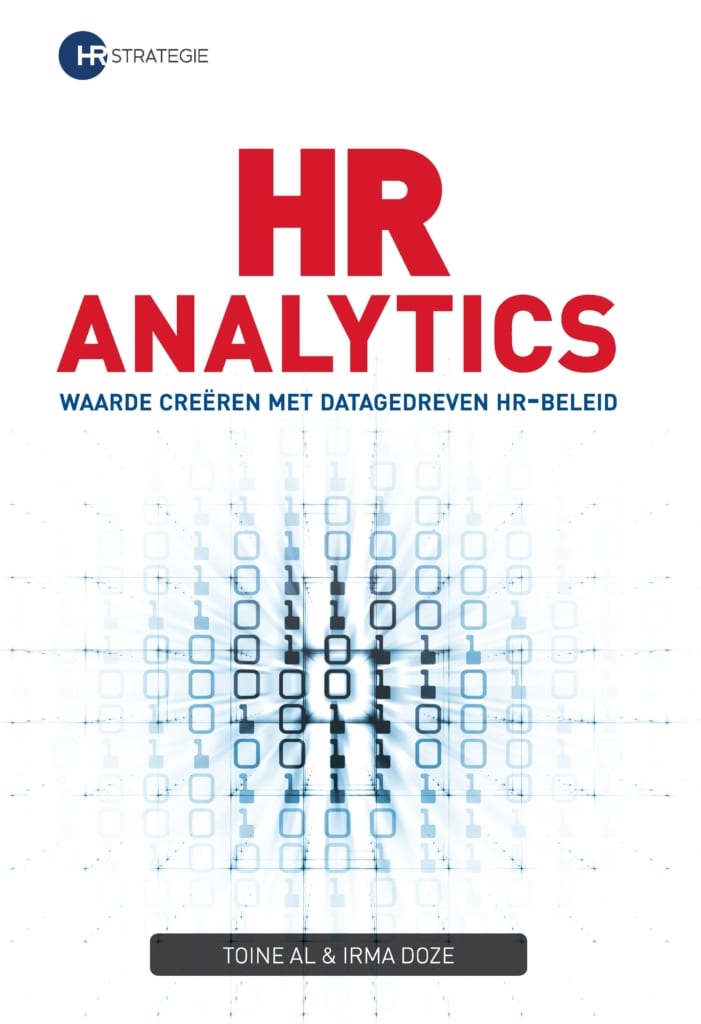Organizations can use HR Analytics as a tool to optimize both their business performance and the employee experience based on facts. HR Analytics differentiates itself because it uses data to gain insights and make recommendations. For every modern organization with an awareness of the enormous difference employees can make in the implementation of organizational strategies, and of the importance of keeping staff costs under control, HR Analytics is an essential discipline. AnalitiQs helps organizations implement HR Analytics and develop skills in the field of HR Analytics.
Why HR Analytics?
- Organizations that base their decisions on data-driven insights perform better. The use of data in the decision-making about an organization’s human capital, the organizational structure and the performance of the HR function is also referred to as Human Resource (HR) Analytics, or data-driven HR.
- The success of organizations is often determined by the people who work there. And as the direct and indirect costs associated with hiring these people account for a significant part of a company’s total costs, HR Analytics can be of great importance to all organizations.
- Since the beginning of the 21st century, the field has undergone enormous development.

Definition of HR Analytics?
The words ‘HR Analytics’ indicate that the field is about (statistical) analyses. That doesn’t cover it all, though. The bigger goal is to provide relevant insights into human resource and organizational topics. The process involves different tools, depending on the problem and the context. This could be a (statistical) analysis as well as an employee survey or an HR Dashboard. So, the goal isn’t really to build a predictive model, for example. The goal is to answer the question as accurately as possible using the correct data and the right tools, depending on the context.
Succes with HR Analytics
Many organizations already have the people to work with HR Analytics. Think for example of Business Intelligence Developers, Data Scientists and Research Analysts. And yet, most organizations fail to create tangible value from the HR Analytics efforts made by these experts.
It requires more than simply adapting some technical profiles for HR Analytics to be successful and for an organization to really make the transition to data-driven HR. If you want to be successful, you need to operate at multiple levels simultaneously.
For example:
- It’s important that the HR Analytics efforts (supply) are aligned with the demand from the line (supply).
- This requires selecting and activating the correct technology.
- You’ll need an HR Analytics target operating model, which includes at least a Translator role.
- Data needs to be generated and administered.
- The necessary Privacy and Security measures must be put in place.
- And last but not least, the HR professionals need to be trained, so they know how the insights can be used.
Where to start?
Successful use of HR Analytics doesn’t happen overnight. The adoption of HR Analytics is like a journey that starts with a destination and is subsequently divided into stages.
Baseline measurement
If an organization is serious about using HR Analytics, the best way to start is with a baseline measurement. Where is the organization now when it comes to aspects like data, operating model, technology, privacy and security management measures, leadership, skills, strategy/research questions? Perhaps there are already some successes to build on?
Goal & Stages
Once the starting point has been defined, it’s time to decide about a destination, divide the journey into stages and within each stage, work towards the finish line of each HR Analytics stage in an agile way.
Want to read more about HR Analytics?
Irma Doze, the founder of AnalitiQs, has a great passion for data. In collaboration with Toine Al she wrote the book “HR Analytics – Creating value with data-driven HR policy”.
This book provides a step-by-step guide to how HR Analytics can be applied to create value for an organization. This data-driven approach enables HR to increase the job satisfaction and performance of the employees and improve the performance of the organization even better.

HR Analytics examples
Are there any organizations that already base their HR decisions on data-driven insights to improve the organization’s performance? In other words: are there already organizations around that are successful with HR Analytics? Absolutely!
HR Data Analysis
Here are some inspiring examples in the field of HR Data Analysis:
Reorganization
A financial service provider used HR Analytics at the time of a reorganization to plot their employees for the new roles, including matching scores. The use of HR Analytics accelerated this giant task enormously, and it resulted in better matching. This specific form of HR data analysis is referred to as prescriptive analytics because it provides people (the HR professionals in this case) with a recommendation based on smart algorithms.
Smart engagement, turnover and absenteeism norms
A retailer uses HR analysis to provide branch managers with smart engagement, turnover and absenteeism norms. The algorithm takes into account aspects like team composition and time of year to determine realistic engagement, turnover and absenteeism rates for each manager. The advantage of this smart standard setting is that managers are no longer presented with uninformative, general standards; they’re given realistic objectives instead. Furthermore, the smart targets allow HR professionals to identify and coach managers that are structurally lagging behind.
Male/female ratio
A governmental institution used predictive HR Analytics to predict to what extent they would be able to fulfil their self-imposed diversification ambition regarding the ratio of male/female employees within the organization. The analysis showed that, despite the significant diversity and inclusiveness efforts made so far, there was still work to do. The analysis resulted in a renewed urgency for the topic as well as the rollout of additional initiatives.
Absenteeism
Several healthcare institutions use diagnostic HR Analytics to identify which staff segments carry a higher risk of absenteeism and what the underlying causes for this are. This type of HR Analytics helps them allocate their available absenteeism budget in an extremely targeted way based on causes and risk groups.
Programme evaluation
A financial service provider uses HR Analytics to measure the effects of their management development programme. For example, does the programme result in a higher level of employee satisfaction among the employees of participating managers compared to those of managers that didn’t participate? This type of HR Analysis can help HR eliminate interventions and programmes that don’t add any value.
Recruitment process and internal mobility
A high-tech company uses HR Analytics process mining to map the flow of candidates through the recruitment process as well as the internal mobility of employees. The insights derived from this HR analysis can help the organization optimize their processes and inform stakeholders if and how processes need to be adjusted.
Talent identification
A building material manufacturer uses prescriptive analytics for talent identification. It reduces the chances of talent being overlooked, which in turn brings down the turnover rate and contributes positively to the company’s cost management.
Employee Surveys
There are also several interesting examples in the field of employee surveys:
Employee sentiment
An organization within the car industry scans, within the limits set by GDPR rules, anonymized emails of employees, and applies text analysis to identify which sentiments are held by the organization’s employees. This type of employee survey ensures that employees and managers aren’t interrupted during their work, while HR and Management do get an idea of the current sentiments existing within the organization and if there are difficulties within specific staff segments or departments.
Employee Journeys
A financial service provider categorizes the cases logged by employees and managers, to identify which Employee Journeys have the most problems/challenges. This type of employee survey ensures that employees and managers aren’t interrupted during their work, while HR does get an idea of the challenges associated with certain Employee Journeys.
Unwanted turnover
A retailer sends every departing employee, whose departure was undesirable, an online questionnaire the day after they’ve handed in their notice, to find out why the employee is leaving and where he or she is going. This helps the organization gain insight into the causes of unwanted resignations.
Employee Engagement
A waste processing company carries out a quarterly pulse survey regarding engagement (eNPS), the critical engagement drivers and current themes. Thanks to this research, the organization has been able to improve employee engagement significantly. It has also provided their managers with a tool to help them listen to employees and start a dialogue.
Culture
A shared services organization used an employee survey to define new cultural values and desired behaviour, and to guide the transition from the current culture and behaviour towards the desired culture and behaviour.
Image
A Dutch city council (one of the top-10 largest cities in the country) used AnalitiQs’ labour market panel in combination with an internal workforce to gain insight into young people’s image of the city council as an employer, as well as the differences in images held between employees and outsiders.
Diversity and Inclusiveness
A media company used an online survey to gain insight into the existing diversity and inclusiveness within their organization, as well as employees’ ideas about the value of diversity and inclusiveness for the organization.
Detailed Service Overview
HR Analysis
Equal Pay
Gender mobility
Absenteeism
Employee Segmentation
Employee Retention & Attrition
Engagement
Impact Measurement / ROI
Learning & Development
Management Development
Onboarding
Organisational Network
Performance
Process Mining
Productivity
Recruitment
Restructuring / Organizational-Development
Reward
Strategic Workforce Planning
Succession Management
Employee Surveys
Culture
Employee Satisfaction
Job Satisfaction
Inclusion
Onboarding
Employee Turnover
Diversity
Employee Community / Panel
Employee Engagement
Employee Commitment
Employee Journey
Employee Net Promotor Score (eNPS)
Employee Value Proposition (EVP)
Employee Enthusiasm
Labour Market
Labour Market Panel
Labour Market Positioning
Leadership
Manager Feedback
Personal Development
Pulse
Retention
Role Clarity
Sentiment
Strategic Alignment
Team Feedback
Total Reward Optimization
Voice of the Employee (VoE)
Work from home
Work Stress
Work Pressure
Capability Building
HR Analytics Strategy
HR Analytics Product Owner
HR Analytics Outsourcing
HR Academy
HR Dashboards
Absenteeism Dashboard
Integral HR Dashboard
Leadership Dashboard
Learning Dashboard
Recruitment Dashboard
Reward Dashboard
Talent Development Dashboard
Interested? Feel free to contact us!

